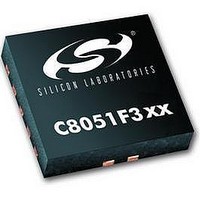C8051F302 Silicon Laboratories Inc, C8051F302 Datasheet - Page 35

C8051F302
Manufacturer Part Number
C8051F302
Description
IC 8051 MCU 8K FLASH 11MLP
Manufacturer
Silicon Laboratories Inc
Series
C8051F30xr
Specifications of C8051F302
Core Processor
8051
Core Size
8-Bit
Speed
25MHz
Connectivity
SMBus (2-Wire/I²C), UART/USART
Peripherals
POR, PWM, Temp Sensor, WDT
Number Of I /o
8
Program Memory Size
8KB (8K x 8)
Program Memory Type
FLASH
Ram Size
256 x 8
Voltage - Supply (vcc/vdd)
2.7 V ~ 3.6 V
Data Converters
A/D 8x8b
Oscillator Type
External
Operating Temperature
-40°C ~ 85°C
Package / Case
11-VQFN
Data Bus Width
8 bit
Data Ram Size
256 B
Interface Type
I2C, SMBus, UART
Maximum Clock Frequency
25 MHz
Number Of Programmable I/os
8
Number Of Timers
16 bit
Operating Supply Voltage
2.7 V to 3.6 V
Maximum Operating Temperature
+ 85 C
Mounting Style
SMD/SMT
Minimum Operating Temperature
- 40 C
On-chip Adc
8 bit
Lead Free Status / RoHS Status
Contains lead / RoHS non-compliant
Eeprom Size
-
Lead Free Status / Rohs Status
No
Available stocks
Company
Part Number
Manufacturer
Quantity
Price
Company:
Part Number:
C8051F302-GMR
Manufacturer:
SiliconL
Quantity:
3 000
Company:
Part Number:
C8051F302-GMR
Manufacturer:
SILICON
Quantity:
5 000
Part Number:
C8051F302-GMR
Manufacturer:
SILICONLABS/èٹ¯ç§‘
Quantity:
20 000
5.3.
ADC0 has a maximum conversion speed of 500 ksps. The ADC0 conversion clock is a divided version of the system
clock, determined by the AD0SC bits in the ADC0CF register (system clock divided by (AD0SC + 1) for
0 ≤ AD0SC ≤ 31).
5.3.1. Starting a Conversion
A conversion can be initiated in one of five ways, depending on the programmed states of the ADC0 Start of Conver-
sion Mode bits (AD0CM2-0) in register ADC0CN. Conversions may be initiated by one of the following:
Writing a ‘1’ to AD0BUSY provides software control of ADC0 whereby conversions are performed "on-demand".
During conversion, the AD0BUSY bit is set to logic 1 and reset to logic 0 when the conversion is complete. The fall-
ing edge of AD0BUSY triggers an interrupt (when enabled) and sets the ADC0 interrupt flag (AD0INT). Note: When
polling for ADC conversion completions, the ADC0 interrupt flag (AD0INT) should be used. Converted data is avail-
able in the ADC0 data register, ADC0, when bit AD0INT is logic 1. Note that when Timer 2 overflows are used as
the conversion source, Timer 2 Low Byte overflows are used if Timer 2 is in 8-bit mode; Timer 2 High byte over-
flows are used if Timer 2 is in 16-bit mode. See
Important Note About Using CNVSTR: The CNVSTR input pin also functions as Port pin P0.6. When the
CNVSTR input is used as the ADC0 conversion source, Port pin P0.6 should be skipped by the Digital Crossbar. To
configure the Crossbar to skip P0.6, set to ‘1’ Bit6 in register XBR0. See
page 95
for details on Port I/O configuration.
Modes of Operation
1.
2.
3.
4.
5.
Writing a ‘1’ to the AD0BUSY bit of register ADC0CN
A Timer 0 overflow (i.e. timed continuous conversions)
A Timer 2 overflow
A Timer 1 overflow
A rising edge on the CNVSTR input signal (pin P0.6)
Section “15. Timers” on page 133
Rev. 2.3
C8051F300/1/2/3/4/5
Section “12. Port Input/Output” on
for timer configuration.
35











